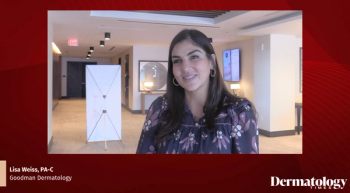
- Dermatology Times, December 2020 (Vol. 41, No. 12)
- Volume 41
- Issue 12
Emerging therapies beyond lasers
Next-generation therapies explore solutions other than laser treatments, and are less invasive, safer and require less downtime.
Acoustic shockwaves, dermal cooling systems, micro-coring skin removal devices and a “smart” needle that guides dermal filler injections are among the emerging therapies that could change dermatologic surgeons’ treatment options for medical and cosmetic patients over the next few years, according to Mathew M. Avram, MD, JD, who led a session on the future of skincare at the American Society for Dermatologic Surgery (ASDS) Annual Virtual Meeting October 9-11.
Innovations like these could address some major current challenges, from improving the appearance of rhytids and skin laxity to clearing benign pigmented lesions, treating cellulite, and increasing the safety of dermal filler injections, says Avram, director of Lasers, Cosmetics, and Dermatologic Surgery at the Massachusetts General Hospital, Boston, Massachusetts.
“These technologies hold promise for enabling procedures that are less invasive, associated with less downtime and safer than our current techniques,” he adds. “It is interesting that none of the emerging advances involves lasers.” Avram’s presentation provides an overview of the novel modalities that may be coming to market and/or seeking approval by the U.S. Food and Drug Administration (FDA).
SKIN SMOOTHING AND LIFTING
A proprietary micro-coring skin removal device (Cytrellis Biosystems), represents an entirely new category of technology in dermatologic surgery, according to Avram. Invented by dermatologists and plastic surgeons at Massachusetts General Hospital, it is a non-energy-based system for smoothing wrinkles and tightening skin. This device is currently undergoing FDA review for marketing clearance.
Applied to the skin on the cheeks, the device removes minute cores of skin (<500 μm in diameter) that account for about 8% of the skin in the area being treated. The procedure is performed with injected anesthesia with lidocaine with epinephrine. According to Avram, it is not painful and has just a few days’ downtime.
Avram says clinical results show improvement in wrinkles and skin laxity 90 days after the third treatment, although patients may experience redness and swelling. He adds that 75% of patients didn’t have to take time off of work, and the treatment is well tolerated, with the average pain reported as a 3.6 on a 0-to-10 scale.
“This is not a replacement for a facelift. But the results from the premarketing study show significant improvement in facial wrinkles and skin laxity that exceeds the benefits achievable with nonablative and fractional ablative devices,” he says.
PIGMENTED LESIONS
A novel dermal cooling system (CryoAesthetic, R2 Technologies) already has FDA clearance for treating benign pigmented lesions of the skin. Now, it’s being developed further to treat lentigines, seborrheic keratosis and other benign types of hyperpigmentation.
Avram says the device allows for more precise and controlled lesion freezing compared with conventional cryotherapy. There are other considerations when weighing it against laser treatments. “Although the treatment may not be quite as effective as a laser procedure, it is better tolerated and appears to result in fewer side effects and less downtime,” he says.
CELLULITE SOLUTION
Already cleared by the FDA for tattoo removal, a device that uses proprietary acoustic shockwaves (Rapid Acoustic Pulse, Soliton) is being developed as a completely noninvasive approach for treating cellulite.
Avram explains that the shockwaves shear the fibrotic septa that contribute to the appearance of cellulite dimpling by pulling the upper layers of skin down towards the superficial muscular aponeurotic system. Clinical trials show the procedure is well-tolerated without any anesthesia and takes about 20 to 30 minutes, which means it could be done in the office. In addition, there were no unexpected or serious adverse events and no downtime.
In the pivotal clinical trial, which included 67 subjects, the average procedural pain score rating was 2.4 out of 10. Among 62 patients included in the efficacy analysis, 85% were judged as treatment responders after a single session. Average percentage improvement in Cellulite Severity Score was 32.5% (range 6.7% to 85.7%), and 92% of patients agreed or strongly agreed that their cellulite appeared improved.
SAFETY INNOVATION
The design of a new “smart” needle (S3 Inject, Blossom Innovations) aims to improve the safety of dermal filler injections. The device, also developed by a team at Massachusetts General Hospital, emits both audio and visual (light) alerts to surgeons as real-time feedback if the needle tip is positioned within a blood vessel.
“Accidental intra-arterial injection is the most feared complication of filler procedures because it can lead to tissue necrosis, ulceration, and even blindness if the filler is injected into the retinal artery,” says Avram. “Thankfully intra-arterial injection is an infrequent complication, but it is a significant concern considering its potentially devastating consequences and the millions of filler procedures performed each year.”
The sensing technology is in the needle itself; 27- and 28-gauge needles will be available first, other sizes will be added later. It is used in the same manner as conventional needles.
“This device is still undergoing investigation, but it holds valuable potential for preventing one of the most serious complications of a common dermatologic surgery procedure,” he adds.
Disclosure: Mathew M. Avram, MD, JD, is on the medical advisory board for Soliton and the scientific advisory board for Cytrellis.
Articles in this issue
about 5 years ago
Half of patients with AD satisfied with treatmentabout 5 years ago
Review links GI disorders, rosaceaabout 5 years ago
Dermatology Times celebrates its 2020 Giants of Dermatologyabout 5 years ago
Pandemic Lessonsabout 5 years ago
Age discrimination in the era of COVIDabout 5 years ago
Adolescent acne therapies benefit younger childrenabout 5 years ago
JAKs may predict psoriasis riskabout 5 years ago
Study links vitamin D deficiency with acneabout 5 years ago
Puzzling PRP possibilities and dermatologyabout 5 years ago
Narrow-spectrum antibiotics viable treatment option for acneNewsletter
Like what you’re reading? Subscribe to Dermatology Times for weekly updates on therapies, innovations, and real-world practice tips.

















